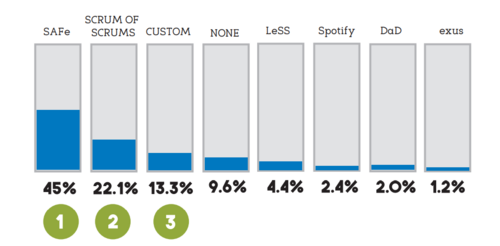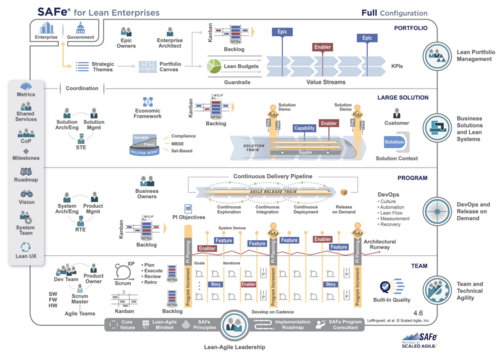(Re)Introducing Project Management in a SAFe world
Traditionally Software development has utilized Project Managers and Project Management. But With the introduction of the Scaled Agile Framework (SAFe) into development organizations from its release in 2011, the most popular Enterprise scale Agile model in the world effectively advocated removing Project Managers from development organizations. The early SAFe versions advocacy of a new organization with new roles took traditional project manager responsibilities and moved them (partially) into the new SAFe's roles such as Product Owners, Scrum Masters and RTE’s. This led many organizations to "throw out the baby with the bathwater" by ignoring the value of those project, program and portfolio management practices that were not incorporated or clearly articulated in these early versions of SAFe. During the period 2011-2017 Project management as a separate formal practice within many software development Organizations literally had no place in those organizations that tried to fully deploy SAFe as written. This is important because as of 2017 the SAFe methodology was used by 45% [1] of those firms using an Agile methodology at scale. Many of these firms have had to contend with a number of issues that this caused up until the acceptance of Project Management through its "introduction" in the form of an Agile Project Management Office (APMO) in the 2017 release of SAFe version 4,5. This implicitly accepted the role PMO's play in strategy formation, Project and Program execution as well as owning and disseminating best practices (in this case represented in the SAFe model by the "Lean Centre of Excellence"). This development represents and acceptance from SAFe that their model should incorporate these project project, program and portfolio practices that had been dropped in previous versions. In this article we look at the issues that have arisen in many firms during their SAFe implementations and explore whether the new APMO solves these issues or not. The article is intended for practitioners who are working in or with organizations that have deployed early versions of SAFe as part of the support for establishing an APMO along the lines now advocated by SAFe. Note: Due to the relatively new and evolving nature of SAFe there is limited empirical data around specific “Implementation issues in Large Scale Agile transformations”. As a consequence this article is more reliant more on Anecdotes, Personal Experience and other literature in this space.
Contents |
Scaled Agile Framework (SAFe)
What is SAFe?
SAFe is the most popular Scaling Agile methodology According to the extensive "Scaling Agile Report 2017" by C-Prime .[1]
According to ScaledAgileFramework.com[2]:
Quoting Dean Leffingwell (the creator and chief methodologist of SAFe) [2]
“SAFe® for Lean Enterprises is a knowledge base of proven, integrated principles, practices, and competencies for achieving business agility using Lean, Agile, and DevOps.” “It “…is built around the Seven Core Competencies of the Lean Enterprise that are critical to achieving and sustaining a competitive advantage in an increasingly digital age”
ScaledAgileFramework.com illustrates the overall framework below. It makes this framework and support material available to all along with an extensive library of resources that can be used for free to support implementing and running SAFe in practice
The seven core competencies from the Sacledagileframework.com[2]:
"Lean-Agile Leadership – Advancing and applying Lean-Agile leadership skills that drive and sustain organizational change by empowering individuals and teams to reach their highest potential
Team and Technical Agility – Driving team Agile behaviors as well as sound technical practices including Built-in Quality, Behavior-Driven Development (BDD), Agile testing, Test-Driven Development (TDD), and more
Agile Product Delivery – Building high-performing teams-of-teams that use design thinking and customer-centricity to provide a continuous flow of valuable products using DevOps, the
Continuous Delivery Pipeline, and Release on Demand Enterprise Solution Delivery – Building and sustaining the world’s largest software applications, networks, and cyber-physical solutions
Lean Portfolio Management – Executing portfolio vision and strategy formulation, chartering portfolios, creating the Vision, Lean budgets and Guardrails, as well as portfolio prioritization, and road mapping
Organizational Agility – Aligning strategy and execution by applying Lean and systems thinking approaches to strategy and investment funding, Agile portfolio operations, and governance
Continuous Learning Culture – Continually increasing knowledge, competence, and performance by becoming a learning organization committed to relentless improvement and innovation"
What are the benefits of SAFE?
What issues are raised with SAFe in operation?
- PM’s and Agile coaches - Interfaces with the rest of the organization & Customers - Changes in roles and responsibilities – PO’s, - Dependency management - Budgets - Tooling changes
SAFe Implementation methodology
What is the new SAFe APMO ?
Does the new SAFe APMO address the issues raised in previous versions of SAFe?
As Dean Leffingwell himself says in his 2010 book "Agile Software Requirements"[3] "Project Managers should be re-tasked as Agile Project Managers." This thought published before the release of SAFe appears to have taken some time to emerge in the SAFe framework
Suggestions for further reading
Agile: The Agile Manifesto: https://agilemanifesto.org/ Agile Alliance: https://www.agilealliance.org/resources
- ↑ 1.0 1.1 C-Prime, https://www.cprime.com/wp-content/uploads/woocommerce_uploads/2017/09/cPrime-Scaling-Agile-Survey-17-Digital.pdf, (NC-Prime, 2017), p14.
- ↑ 2.0 2.1 2.2 https://www.scaledagileframework.com/about/
- ↑ Dean Leffingwell, Agile Software Requirements, (Wesley, 2010),

